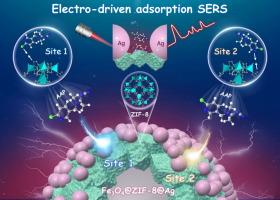Multifunctional Fe3O4@ZIF-8@Ag nanocomposites and electro-driven droplet adsorption strategy for SERS detection of acetamiprid
IF 13.2
1区 工程技术
Q1 ENGINEERING, CHEMICAL
引用次数: 0
Abstract
Surface-enhanced Raman scattering (SERS) is strategically employed for label-free detection of trace analytes. The weak affinity of target analytes with SERS substrate and complex matrix interference impede the achievement of high sensitivity and precision necessary for practical SERS applications. Based on Fe3O4@ZIF-8@Ag substrate and the electro-driven adsorption strategy, this study develops a droplet SERS sensor for direct quantification of acetamiprid (AAP) residue. Through the internal structure of ZIF-8, AAP molecules can be adsorbed onto the “hotspot” region of Ag nanoparticles (Ag NPs) to obtain enhanced SERS signals. The magnetic substrate can simplify sample pretreatment and reduce complex matrix interference. An electric field can strengthen the van der Waals interaction between AAP and SERS interface, providing a driving force for the adsorption of AAP molecules. Compared to static adsorption in 60 min without an electric field, effective adsorption of AAP can be achieved in 7 min by applying a potential of − 0.5 V. Moreover, the electro-driven SERS offers 9 times higher in sensitivity compared with that of normal SERS, with a limit of detection (LOD) down to 4 nM. This strategy is confirmed by UPLC-MS/MS analysis of AAP in real samples, demonstrating a new, simple, flexible, and sensitive SERS technique applicable for pesticide residue detection.

多功能Fe3O4@ZIF-8@Ag纳米复合材料及电驱动液滴吸附策略对啶虫脒的SERS检测
表面增强拉曼散射(SERS)被战略性地用于痕量分析物的无标记检测。目标分析物与 SERS 底物的亲和力较弱以及复杂的基质干扰阻碍了 SERS 实际应用所需的高灵敏度和高精度的实现。本研究以 Fe3O4@ZIF-8@Ag 为基底,采用电驱动吸附策略,开发了一种用于直接定量检测啶虫脒(AAP)残留的液滴 SERS 传感器。通过 ZIF-8 的内部结构,AAP 分子可以被吸附到银纳米粒子(Ag NPs)的 "热点 "区域,从而获得增强的 SERS 信号。磁性基底可以简化样品预处理,减少复杂的基质干扰。电场可以加强 AAP 与 SERS 界面之间的范德华相互作用,为 AAP 分子的吸附提供驱动力。与无电场情况下 60 分钟的静态吸附相比,施加 - 0.5 V 的电位只需 7 分钟即可实现对 AAP 的有效吸附。此外,电驱动 SERS 的灵敏度是普通 SERS 的 9 倍,检测限(LOD)低至 4 nM。对实际样品中 AAP 的 UPLC-MS/MS 分析证实了这一策略,展示了一种适用于农药残留检测的简单、灵活和灵敏的新型 SERS 技术。
本文章由计算机程序翻译,如有差异,请以英文原文为准。
求助全文
约1分钟内获得全文
求助全文
来源期刊

Chemical Engineering Journal
工程技术-工程:化工
CiteScore
21.70
自引率
9.30%
发文量
6781
审稿时长
2.4 months
期刊介绍:
The Chemical Engineering Journal is an international research journal that invites contributions of original and novel fundamental research. It aims to provide an international platform for presenting original fundamental research, interpretative reviews, and discussions on new developments in chemical engineering. The journal welcomes papers that describe novel theory and its practical application, as well as those that demonstrate the transfer of techniques from other disciplines. It also welcomes reports on carefully conducted experimental work that is soundly interpreted. The main focus of the journal is on original and rigorous research results that have broad significance. The Catalysis section within the Chemical Engineering Journal focuses specifically on Experimental and Theoretical studies in the fields of heterogeneous catalysis, molecular catalysis, and biocatalysis. These studies have industrial impact on various sectors such as chemicals, energy, materials, foods, healthcare, and environmental protection.
 求助内容:
求助内容: 应助结果提醒方式:
应助结果提醒方式:


